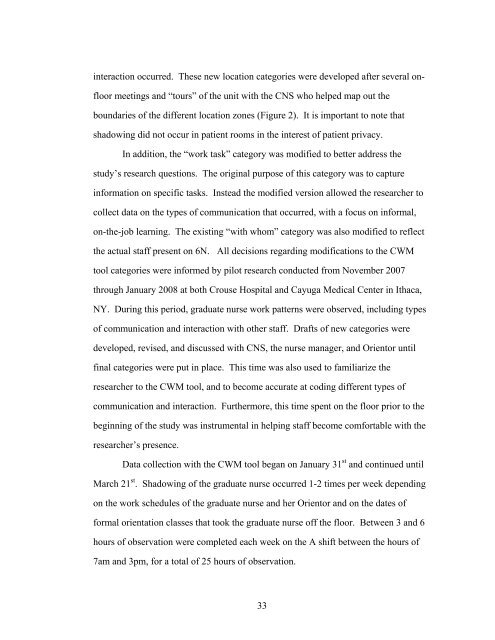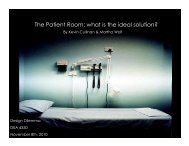The role of physical design and informal communication
The role of physical design and informal communication
The role of physical design and informal communication
You also want an ePaper? Increase the reach of your titles
YUMPU automatically turns print PDFs into web optimized ePapers that Google loves.
interaction occurred. <strong>The</strong>se new location categories were developed after several on-<br />
floor meetings <strong>and</strong> “tours” <strong>of</strong> the unit with the CNS who helped map out the<br />
boundaries <strong>of</strong> the different location zones (Figure 2). It is important to note that<br />
shadowing did not occur in patient rooms in the interest <strong>of</strong> patient privacy.<br />
In addition, the “work task” category was modified to better address the<br />
study’s research questions. <strong>The</strong> original purpose <strong>of</strong> this category was to capture<br />
information on specific tasks. Instead the modified version allowed the researcher to<br />
collect data on the types <strong>of</strong> <strong>communication</strong> that occurred, with a focus on <strong>informal</strong>,<br />
on-the-job learning. <strong>The</strong> existing “with whom” category was also modified to reflect<br />
the actual staff present on 6N. All decisions regarding modifications to the CWM<br />
tool categories were informed by pilot research conducted from November 2007<br />
through January 2008 at both Crouse Hospital <strong>and</strong> Cayuga Medical Center in Ithaca,<br />
NY. During this period, graduate nurse work patterns were observed, including types<br />
<strong>of</strong> <strong>communication</strong> <strong>and</strong> interaction with other staff. Drafts <strong>of</strong> new categories were<br />
developed, revised, <strong>and</strong> discussed with CNS, the nurse manager, <strong>and</strong> Orientor until<br />
final categories were put in place. This time was also used to familiarize the<br />
researcher to the CWM tool, <strong>and</strong> to become accurate at coding different types <strong>of</strong><br />
<strong>communication</strong> <strong>and</strong> interaction. Furthermore, this time spent on the floor prior to the<br />
beginning <strong>of</strong> the study was instrumental in helping staff become comfortable with the<br />
researcher’s presence.<br />
Data collection with the CWM tool began on January 31 st <strong>and</strong> continued until<br />
March 21 st . Shadowing <strong>of</strong> the graduate nurse occurred 1-2 times per week depending<br />
on the work schedules <strong>of</strong> the graduate nurse <strong>and</strong> her Orientor <strong>and</strong> on the dates <strong>of</strong><br />
formal orientation classes that took the graduate nurse <strong>of</strong>f the floor. Between 3 <strong>and</strong> 6<br />
hours <strong>of</strong> observation were completed each week on the A shift between the hours <strong>of</strong><br />
7am <strong>and</strong> 3pm, for a total <strong>of</strong> 25 hours <strong>of</strong> observation.<br />
33







